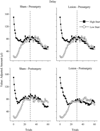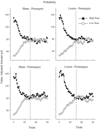Nucleus accumbens lesions decrease sensitivity to rapid changes in the delay to reinforcement
- PMID: 16884790
- PMCID: PMC4083481
- DOI: 10.1016/j.bbr.2006.06.024
Nucleus accumbens lesions decrease sensitivity to rapid changes in the delay to reinforcement
Abstract
Both humans and non-humans discount the value of rewards that are delayed or uncertain, and individuals that discount delayed rewards at a relatively high rate are considered impulsive. To investigate the neural mechanisms that mediate delay discounting, the present study examined the effects of excitotoxic lesions of the nucleus accumbens (NAC) on discounting of reward value by delay and probability. Rats were trained on delay (n=24) or probability discounting (n=24) tasks. Following training, excitotoxic lesions of the NAC were made by intracranial injections of 0.5 microl 0.15 M quinolinic acid (n=12) or vehicle (n=12) aimed at the NAC (AP +1.6, ML +/-1.5, DV -7.1). NAC lesions did not alter performance in animals tested with a constant delay (4s) or probability (0.4) of reinforcement. However, when tested with between session changes in the delay (0, 1, 2, 4, and 8s) of reinforcement, the lesioned rats had flatter discount curves than the sham group, indicating that they were less sensitive to frequent changes in the delay to reward. In contrast, the NAC lesions did not affect discounting of probabilistic rewards. NAC lesions impaired the ability to adapt to frequent between session changes in the delay to reward but did not increase or decrease discounting when the delay was held constant across sessions. NAC lesions may disrupt the ability of the animals to predict the timing of delayed rewards when the delay to reward is changed frequently.
Figures







References
-
- APA. Diagnostic and statistical manual of mental disorders: DSM-IV-TR. Washington, DC: American Psychiatric Association; 2000.
-
- Logue AW, Pena-Correal TE. The effect of food deprivation onself-control. Behav Process. 1985;10:355–368. - PubMed
-
- Herrnstein RJ. Self-control as response strength. In: Bradshaw CM, Szabadi E, Lowe CF, editors. Quantification of steady-state operant behavior. Amsterdam: Elsevier; 1981. pp. 3–20.
-
- Ainslie G. Specious reward: a behavioral theory of impulsiveness and impulse control. Psychol Bull. 1975;82(4):463–496. - PubMed
Publication types
MeSH terms
Substances
Grants and funding
LinkOut - more resources
Full Text Sources

